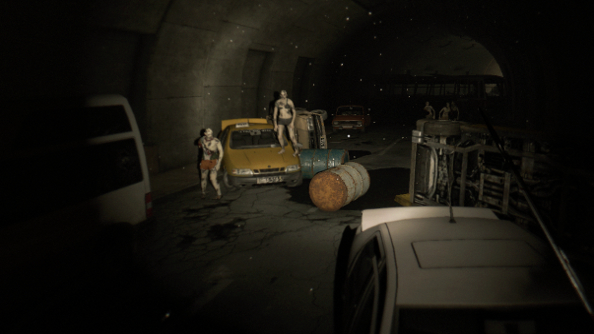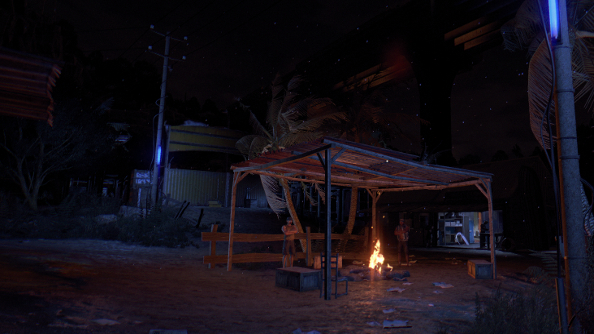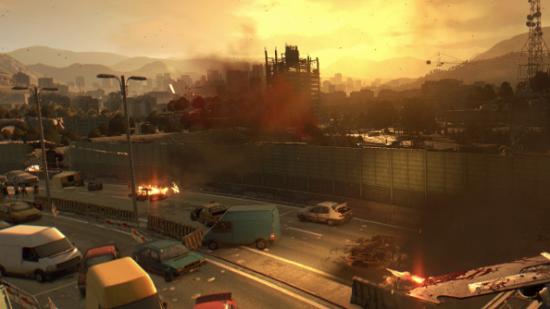From where I’m perched, Harran looks desolate. Plumes of smoke pour out of buildings, and roads are dotted with cars ablaze. But other than the few infernos and the billowing palm leaves, it looks almost peaceful. Clambering down the the Tower of Babel-sized radio tower, the real Harran starts to reveal itself; the zombie-infested city that serves as Dying Light’s blood-drenched stage.
That’s the problem with being above it all – I start to feel safe. But the moment I hit street level, that changes. Falling out of windows, crawling on top of cars, smashing against fences, zombies fill every nook and cranny of the Turkish city. So I swifty ascend again, Spider-man without the jokes, and I stare out across the roofs. These are the real streets of Harran, the rooftops and balconies, and I sit there and plan. I have to, because the hell below is bubbling with danger.

Dying Light, like most sprawling open-world games, does not make a good first impression. A plodding intro cutscene followed by an hour of busy work and tutorial missions is an awful way to start off a game that’s all about exploration and non-linear progression. I was exhausted before things had really kicked off. But like an attempt to eat a turtle, I needed to break through the unappetising shell to get to the juicy good bits.
Techland made Dead Island, an open-world zombie game with lots of customisable melee weapons and 4-player co-op. Dying Light is an open-world zombie game with lots of customisable weapons and 4-player co-op. These games are nothing like each other.
It was a surprise to find just how vast the gulf between this and Techland’s last zombie outing turned out to be, especially since Dying Light mimics lots of other open-world games, particularly those unwieldy, bloated Ubisoft ones, with maps similarly bursting with icons and diversions. The parkour that lies at the centre of Dying Light is a domino, knocking over all the others, informing all elements of the game until it bears little similarity to its predecessor. It isn’t so much a zombie game, as it is a parkour game with zombies. Ignoring direction and the flavourless, endlessly repetitive missions – which never feel like more than mundane tasks – in favour of exploring the city is key to getting the most out of it.

Right after the prologue Harran opens up, ripe for vertical exploration, looting, and grisly zombie-killing. The whole city is a theme park dedicated to running and slaughtering. Every building can be scaled, usually with ease, and frequently ransacked for weapon parts, chemicals and, of course, chocolate and cigarettes. Prison currency goes a long way here.
With the streets of the city playing host to an ocean of hungry walking corpses, exploring the city from above is the safest way to go. And by far the most fun. Early on, I thought it almost matched Mirror’s Edge, though it lacked that game’s grace. Now, I couldn’t say which one has superior movement.
They are different, and with Dying Light using RPG-like progression, it takes a while before hero Kyle Crane – a gloriously awful action movie name – reaches his peak. But it’s his occasional fumbles, the moments where he’s completely out of breath, his vision clouding, that make running high above the zombie hordes so compelling.
It’s at night when navigating the map becomes a proper delight, though. No, not delight. That’s the wrong emotion. Unrelenting, ass-clenching terror is more appropriate. During the day, there are plenty of threats, but when the sun sets, Dying Light becomes a survival horror game.

With my co-op companion, Rob, in tow, I strike out into the night, leaving one the game’s small pockets of humanity behind me. We have a mission, but it’s really just an excuse to brave the dangers of Harran after dark. That’s all missions are in Dying Light, excuses to go wandering. They’re insipid things doled out by bland survivors who never inspire even a tiny amount of investment. But they get me out of the house.
The mission is to go and press some switches – a frequent request – which will result in lots of zombie death. The locations are all spread out, so we know we’re going to be doing a lot of running. We’re not a metre out the door before we freeze. There are things prowling out there, in the pitch black.
Dying Light’s got a lot of different types of zombies, from the ineffectual shambling corpses who can only overpower in numbers, to horrible, fat things that spew out toxic sludge. They’re all a joke compared to the things that lurk in the dark; monstrous things with slimy mandibles that run and climb faster than even Kyle.

These beasties slowly, erratically patrol, from streets to rooftops, searching for prey. So we wait. We watch our mini-map, keeping an eye on their cones of vision. There are two at either side of us, but they both turn away, and we make a break for it.
“Turn off your light,” Rob whispers. I forgot that my torch was on, but frankly, I’m not keen to turn it off. This is true night, not the blue-grey, moonlit nights most games favour. It doesn’t matter, anyway. We’ve been spotted. The sweating starts even before I bolt.
We split up to separate the pack that was now hound us, leaping across buildings, occasionally diving down onto the street, lungs struggling the whole time. We almost collide, and the group following me soon follows, quickly deciding that Rob looks tastier. We’re laughing, but I think mostly out of fear.
Eventually, after more than a few deaths and a horrible encounter with an entire compound filled with zombies, and no room for little old us, we complete the quest. I can’t recall the reward. It’s entirely unimportant. The tension, the fear, our half-blind sprint through a dead city, that was the prize.

I could be immensely boring and point out that going out at night offers more experience points, put split into three trees with three tiers, survival, agility and power. So there’s a payoff for all that danger. But that’s a truly terrible reason to do anything. That’s not to say that progression isn’t important in Dying Light. It is. And it’s actually pretty well integrated into the rest of the game instead of feeling like something that’s been ripped out of an RPG and then stitched onto what is, admittedly, a Frankenstein’s monster of open world games.
Kyle gets tougher, stronger, more agile and better at crafting through his actions, and not through quest rewards. Or, at least, not exclusively. Travelling through the city in interesting ways, making seemingly impossible jumps, walking down a road by bouncing from car roof to car roof, that’s how agility experience is earned. And with every new level, a new skill can be unlocked, like sliding under gaps in walls or, in the power tree, instantly killing stunned zombies.
There’s never any need to think about levelling up or grinding, it just happens. Fighting a lot of zombies makes it easier to fight them. Surviving the night or clearing out a nest of zombies in a safe house makes it easier to survive in future. It’s organic.

A rhythm runs through Dying Light, but there are interruptions, and they threaten to sour the whole experience. There are the aforementioned quests and utterly forgettable characters that yammer away on the radio, and there’s that tired story of some white American bloke coming to a foreign land to save the day. It’s drek, and it creates an awkward tug of war between the anecdote fuel provided by emergent open world and the scripted nonsense.
When I am out exploring, looking for peaks to jump off, searching for that next rush, the last thing I need is some chatty ex-kickboxer and her parkour-instructor chum, both of whom lead the main group of survivors, moaning and whining. They never give it a rest, telling me to slave away for them because they are utterly incapable of doing anything themselves, despite having survived for a good long time before I came along.
It makes me want to hit something. It’s fortunate, then, that there’s a lot to hit. Dying Light’s scrappier side is uneven, lamentably. The focus is on melee combat, for fairly logical reasons. Zombies are attracted by loud noises. Guns are loud. Knives are not.
A mountain of makeshift weapons can be found among the detritus of human civilization, from the humble table leg to the brutal steel rebar. Bludgeoning weapons are always the right choice. Caving in a zombie skull, causing the whole rotting head to explode, is a singular delight. The blunt instruments all feel hefty, and whenever they connect with one of the undead, there’s satisfying feedback. Blades, on the other hand, cut through everything like air, and are entirely unsatisfying.

Regardless of the weapon, however, combat is a right old slog. Even the most mundane of zombies can take a serious beating, even after investing in power skills, to the point where it becomes almost comical. The weak zombies collapse pretty quickly, but still need to be bashed over and over and over again until they stay down. And in between that, there’s invariably a break so stamina can regenerate.
Dying Light can be a bit of a killjoy, honestly. Even after levelling up countless times, stamina decreases rapidly in combat, making attacks as deadly as a soft caress. This necessitates a brief retreat, so the bar can regenerate. It prolongs already unnecessarily long fights, and simply doesn’t make sense. How can a man with the agility of a bloody superhuman get completely knackered from swinging a pipe for 30 seconds? It’s a poorly veiled attempt to manufacture challenge without actually making combat more nuanced. And it’s not the only one.
Weapons play by similar rules, but instead of stamina, they have durability. When used sparingly, having weapons that can break down can inspire more exploration, like a desperate hunt for parts to repair a beloved wrench that can also electrocute zombies. But Techland hasn’t used it sparingly.

Weapons start to lose their durability rapidly, and one big fight can see an entire inventory smashed to pieces. Worse, repairs are limited. A weapon can only be repaired so many times before it becomes completely useless, making it pointless to invest time and money into weapons that might soon be lost. I don’t think the mechanic has been thought through at all, as evidenced by the fact that you can not only equip completely broken weapons, but you can use hard-to-find upgrades on them, too, wasting them.
It’s a genuine shame that so much of the combat is overshadowed by these problems, because it can also be challenging and inventive. The tougher undead need to be outwitted, because going one on one with them is a death sentence. And large, troublesome group can be manipulated with firecrackers, made to wander into massive fires or an explosion radius, or thrust onto spikes and other traps.
They are as dumb as they are deadly, so a smart survivor can corral them like cattle. Entire hordes of them can be taken out at once in glorious, fiery displays, their twitching bodies piled up on top of each other like some undead orgy.

When fights do get to be a bit much, though, there’s always an escape route nearby, and something new to do. An race to an airdrop full of vital supplies, with the oh so very bad baddies with their villain costumes attempting to get there first; dynamic co-op missions that crop up mid-game, spicing things up; new, increasingly horrible monsters to run away from; and even dungeon-like, bastard-hard, quarantine areas hiding lovely loot to fight through.
Most of Dying Light’s diversions attempt to be distinct, and when they aren’t awful escort sidequests our completely out of place races and weapon challenges, they’re usually worth engaging.
Despite taking cues from other open world games, ones nobody could ever accuse of being fresh, Techland has molded these borrowed parts into something that is occasionally formidable. Dying Light never quite shakes off the spectre of these other games, but it doesn’t play it as safe, presenting a world that is infinitely more deadly and fraught with tension. It is at its best, though, when the game doesn’t get in the way of itself; when there are no calls on the radio or breaks in combat for a rest and a cup of tea.
